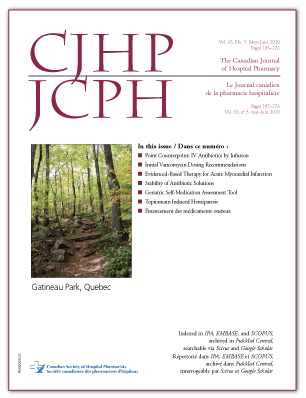Acceptability and Face Validity of a Geriatric Self-Medication Assessment Tool
DOI:
https://doi.org/10.4212/cjhp.v63i3.918Keywords:
medication therapy management, geriatric assessment, self-care, medication adherence, validation studies, gestion du traitement médicamenteux, évaluation gériatrique, autosoins, observance du traitement médicamenteux, études de validationAbstract
ABSTRACT
Background: A majority of community-dwelling older adults manage their own medication regimens. This study describes the development and first phase of testing of the Self-Medication Assessment Tool (SMAT), designed to screen for cognitive and functional deficits in relation to medication self-management among community-dwelling geriatric patients.
Objective: To evaluate the face validity of the SMAT and to determine its acceptability among pharmacists.
Methods: An instrument was designed, with 5 assessment scales to measure function, cognition, medication recall, and 2 aspects of adherence. The instrument included a standardized test kit and instructions for testers. Focus groups interviews, individual interviews, and surveys were used to determine the reactions of community and hospital-based pharmacists to the tool. Transcripts of the focus group and individual interviews were coded for main themes. Pharmacists’ ratings of usefulness, thoroughness, and ease of use, as well as their willingness to use the instrument, were compared with a neutral rating on a 7-point scale by means of 1-sample t tests.
Results: Focus group interviews or individual interviews were conducted with 17 pharmacists and 3 pharmacy students (out of a potential population of about 300) who responded to an invitation to participate. The pharmacists felt that the tool would be useful in identifying difficulties with medication management and potential interventions, and they expressed a willingness to use it in their respective practices. Pharmacists working in hospital settings were slightly more willing than community pharmacists to use the tool. Interviewees highlighted ways to improve the tool before testing of its psychometric properties in the planned second phase of this project.
Conclusions: The SMAT had strong face validity and was particularly acceptable for use by pharmacists in hospital settings.
RÉSUMÉ
Contexte : Une majorité d’adultes âgés vivant dans la communauté gèrent eux-mêmes la prise de leurs médicaments. Cette étude décrit la mise au point et la phase initiale de la validation d’un outil d’évaluation de l’automédication (OEAM) conçu pour dépister les déficits cognitifs et fonctionnels relatifs à l’augotestion des médicaments chez les patients gériatriques vivant dans la communauté.
Objectif : Évaluer la validité apparente de l’OEAM et déterminer son acceptabilité chez les pharmaciens.
Méthodes : Un outil comportant cinq échelles d’évaluation a été conçu pour mesurer les capacités fonctionnelles, la cognition, le rappel des connaissances sur les médicaments et deux aspects de l’observance. L’outil était pourvu d’une trousse de validation standardisée et d’instructions pour les essayeurs. Des entrevues de groupe, des entrevues individuelles et des sondages ont été utilisés pour déterminer les réactions des pharmaciens communautaires et hospitaliers face à l’outil. Les transcriptions des entrevues de groupe et des entrevues individuelles ont été codées pour ce qui est des principaux thèmes. Les notations des pharmaciens quant à l’utilité, à la rigueur et à la facilité d’emploi, ainsi qu’à leur propension à l’utilisation ont été comparées à une notation objective sur une échelle de sept points à l’aide de tests t pour échantillon unique.
Résultats : Les entrevues de groupe ou individuelles ont été menées chez 17 pharmaciens et trois étudiants en pharmacie (provenant d’une population potentielle d’environ 300) qui ont accepté l’invitation à participer. Les pharmaciens ont estimé que l’outil serait utile pour cerner les difficultés de gestion des médicaments et les interventions potentielles, et ils ont exprimé leur propension à l’utiliser dans leur milieu d’exercice respectif. Les pharmaciens en milieu hospitalier étaient un peu plus enclins à utiliser l’outil que leurs collègues du secteur communautaire. Les interviewés ont souligné des façons d’améliorer l’outil avant d’en tester les propriétés psychométriques dans la deuxième phase anticipée de ceprojet.
Conclusions : L’OEAM avait une validité apparente élevée et son utilisation était particulièrement acceptable par les pharmaciens en milieu hospitalier.
Downloads
Downloads
Issue
Section
License
Copyright © Canadian Society of Healthcare-Systems Pharmacy.
After publication of a manuscript in the CJHP, the authors of the manuscript must obtain written permission from the CSHP (publications@cshp.ca) before reproducing any text, figures, tables, or illustrations from the work in future works of their own. If a submitted manuscript is declined for publication in the CJHP, all said rights shall revert to the authors. Please note that any forms (e.g., preprinted orders and patient intake forms) used by a specific hospital or other health care facility and included as illustrative material with a manuscript are exempt from this copyright transfer. The CJHP will require a letter from the hospital or health care facility granting permission to publish the document(s).










